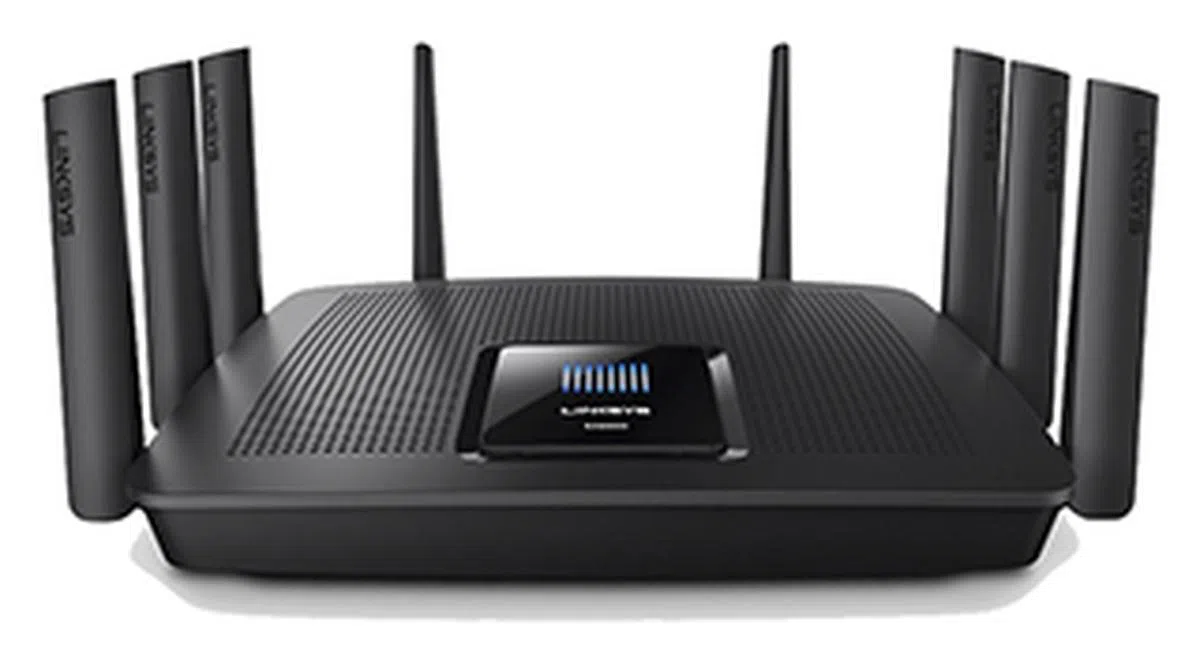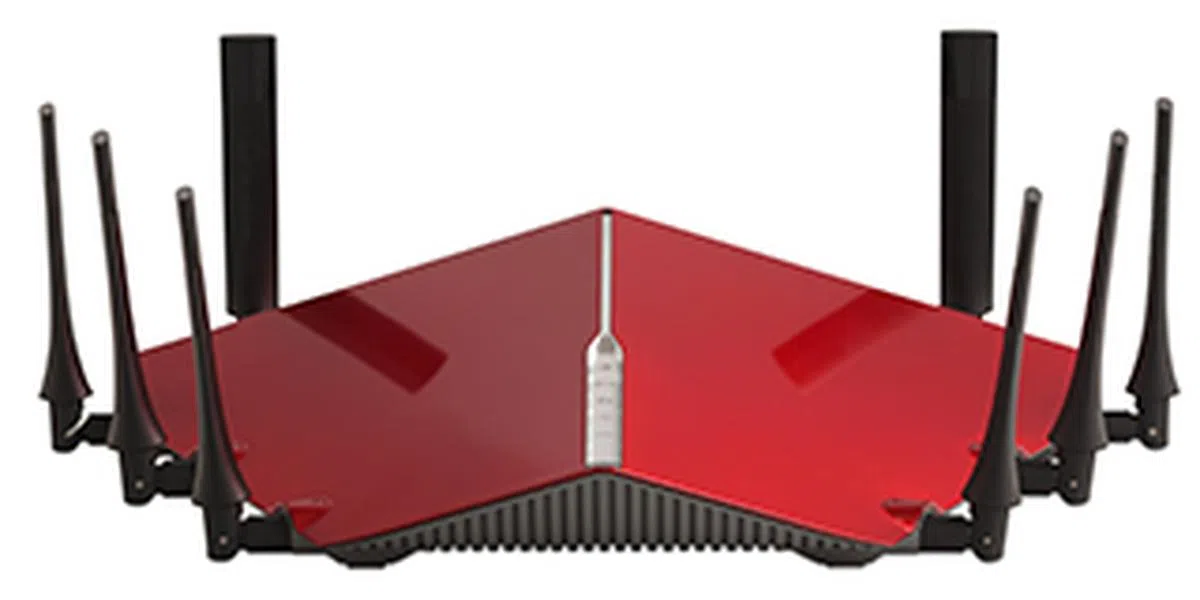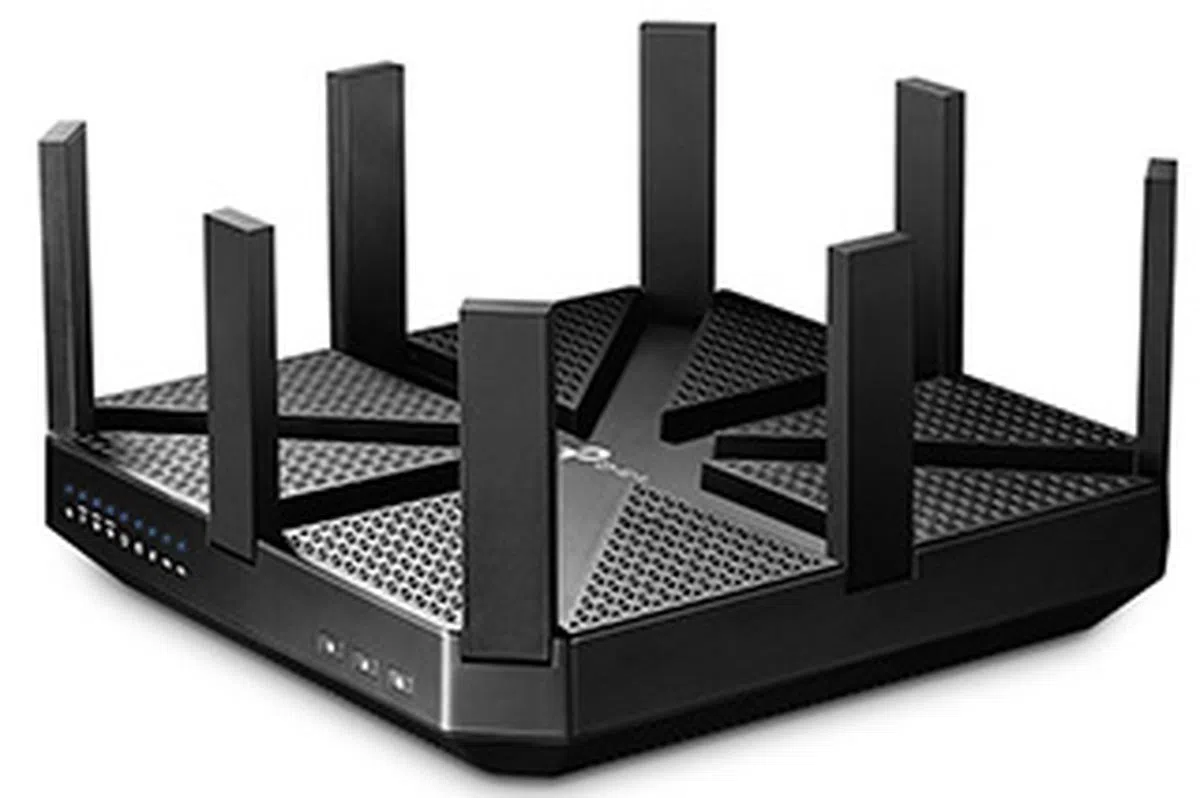AC5300 Wireless Router Shootout: D-Link vs. Linksys vs. TP-Link
If you want to splash the cash on a new uber router, AC5300 routers are the way to go. We put three of the newest AC5300 routers to the test here to find out which is best.
By Kenny Yeo -
Note: This article was first published on Dec 28, 2016.
A case for AC5300 routers
For readers who demand the very best in wireless connectivity, AC5300-class routers are what you want because they offer both speed and bandwidth. In case, you don't already know, the two are somewhat related, but not entirely the same.

AC5300-class routers are able to deliver the highest speeds and the greatest bandwidth, which makes them excellent for demanding users. (Image source: Linksys)
On the speed front, because of their support of 4x4 streams and NitroQAM technology, they are able to offer maximum transfer speeds of up to 2,167Mbps on their 5GHz networks. For sheer speed, only AC3100-class routers can match up to the AC5300-class routers.
On the bandwidth front, AC5300-class routers broadcast three distinct networks (one more than the AC3100-class routers), allowing them to accommodate more wireless devices. To recap, AC5300 routers broadcast a single 2.4GHz network and two 5GHz networks. The single 2.4GHz network supports speeds of up to 1,000Mbps while the two 5GHz networks manage 2,167Mbps each - add them all up and you get 5,334Mbps.
In addition, these AC5300-class routers also support MU-MIMO technology. MU-MIMO or Multi-User Multiple Input Multiple Output is a technology that enables a router to transmit data to compatible multiple devices simultaneously. This is great for users who have many connected devices that are being used concurrently. Presently, non MU-MIMO routers can only transmit data to a single client device at any one time, which explains why performance deteriorates rapidly when multiple devices are connected to a router. You can read more about MU-MIMO technology in our review of the Linksys EA8500 router, the first router to officially support MU-MIMO out of the box.
As a result, AC5300-class routers are the ideal routers for household who demand the utmost in speed and bandwidth.
We've already reviewed two earlier AC5300-class routers that debuted in 2015 from ASUS and Netgear. For this shootout, we pit three newer models that launched in 2016 from Linksys, D-Link and TP-Link.
Linksys EA9500 Max-Stream AC5400 MU-MIMO Gigabit router

The Linksys EA9500 router is huge and full of antennas.
We begin this shootout with the Linksys EA9500 router, which was reviewed earlier this year in July. You can find out more about the router in our original review here, so we will only go through the router’s key highlights now.
The EA9500 is Linksys’ new flagship router and the first thing that strikes you about it is its sheer size. It is over 30cm wide, 7cm thick, and weighs a hefty 1.7kg. It is also full of antennas. There are eight of them and they are non-removable to provide the router with a fixed antenna gain, allowing the router to better calculate and maintain beamforming signals.

The Linksys EA9500 router provides users with not 4, but 8 Gigabit Ethernet ports! There's also a USB 3.0 and another USB 2.0 port.
The back of the EA9500 router is even more interesting as it has not the usual four, but eight Gigabit Ethernet LAN ports! This is a much welcomed feature, considering the amount of connected devices we have today. Our only gripe is that these LAN ports do not support port aggregation. There's also a USB 3.0 and a USB 2.0 port for connecting to printers and external storage devices for print and file sharing.
Inside, the EA9500 router is powered by Broadcom’s 5G XStream platform, which consists of a 1.4GHz dual-core Broadcom BCM4709 processor and three BCM4366 radios. This is what allows the EA9500 router to attain its AC5300 rating.

The Linksys Smart Wi-Fi interface is well designed and arguably the most user-friendly and simple to use. In this menu, users can easily manage their Wi-Fi settings.
On the setup and software side of things, the EA9500 router gets Linksys’ excellent Smart Wi-Fi user interface and software stack. It is one of the most straightforward and user-friendly router setup interface to use, and offers features like traffic monitoring, networking mapping, parental control, and more.
Check out our original review of the Linksys EA9500 router to learn more about this router.
D-Link DIR-895L AC5300 MU-MIMO Gigabit Router

The D-Link DIR-895L is big, bulky, and very red.
The DIR-895L router is D-Link’s flagship router in its high-end Ultra Performance Series of routers. And like the previously reviewed DIR-890L router and DIR-885L router, the DIR-895L comes in bright red and sports an aggressive design. If Lamborghini ever came out with a router, it will probably look like something from D-Link’s Ultra Performance Series.
The DIR-895L router’s highly angular and pyramidal design is something that will divide opinions, but most of the people I showed to around the office loved it. There’s no denying that it is a bold and refreshing design, and there’s no doubting that it is a high-performance router. On a whole, I think it will appeal well to the router’s target audience.

Like the rest of D-Link's Ultra Performance Series routers, the DIR-895L router has a strip of silver running down the middle that houses the LED status indicators.
On the front, a silver strip that runs down the middle houses the router’s LED status indicators. However, it only shows the status of your Internet connectivity, wireless networks, and USB connection. This means that if you are having trouble with your LAN connections, there’s no quick way to see what’s wrong.
Behind the router lies the usual single Gigabit Ethernet WAN port and four Gigabit Ethernet ports. The D-Link DIR-895L comes with a single USB 3.0 ports and another USB 2.0 port. The former can be used to connect to storage devices for easy file-sharing or wireless backups, while the latter can be used to connect to printers for wireless printing. The other thing worth mentioning is that the individual Ethernet ports do not have status indicators, which could make troubleshooting tricky.

The D-Link DIR-895L router has the usual single Gigabit Ethernet WAN port and four Gigabit Ethernet LAN ports as well as a USB 3.0 and USB 2.0 port.
An interesting thing about the DIR-895L router is that there’s a switch behind that changes the mode of the device between “router” and “extender” modes, although that would just make the DIR-895L a very expensive and overpowered Wi-Fi range extender.
Internally, the DIR-895L router features the same innards as other AC5300-class routers. This means it features Broadcom’s 5G XStream chipset, which consists of a 1.4GHz dual-core processor and three Broadcom BCM4366 radios. This allows the DIR-895L router to broadcast a single 2.4GHz network and two 5GHz networks. And thanks to support for NitroQAM technology, the 2.4GHz network supports speeds of up to 1,000Mbps, while the 5GHz networks support speeds of up to 2,167Mbps each, giving the router a total bandwidth of 5,334Mbps. Of course, to support these kinds of speeds requires compatible client devices.

The D-Link's setup interface is easy and straightforward to use, but lacks certain features.
Like most other D-Link routers, the DIR-895L router comes pre-configured right out of the box, with the wireless SSID and password printed on a label that’s under the router. But if you wish to get your hands dirty, D-Link’s setup interface is less intimidating and slightly more straightforward to use. It also has all of the features you would expect to find from a high-end router such as Port Forwarding, Firewall, QoS, Parental Controls, guest access, cloud storage via SharePort, and more.
However, some of its features are more simplistic when compared to its rivals. For example, the DIR-895L’s QoS feature isn’t dynamic and only allows you to prioritize connections based on devices or applications. Some of its competitors have QoS implementations that are dynamic and can recognize and prioritize traffic based on usage scenarios.

SharePort is a handy feature that lets users easily share files on external storage devices connected to the router. It requires a bit of setup and might be a little confusing for less savvy users.
Parents should also take note that the DIR-895L’s parental control features aren’t obvious and quite primitive when compared to newer solutions from the likes of ASUS and Linksys. The problem with the DIR-895L’s parental control feature is that it is a blanket setting that affects all client devices, whereas most other brands have parental control features that allow administrators to create schedules for specific devices. In other words, if you were to cut off Internet connectivity past a certain timing, everyone will be affected and not just your children.
The DIR-895L router also features remote router management via the mydlink Lite app. But in truth, the implementation is very basic and simplistic and doesn’t really let users do anything other than check on its status and rebooting it remotely. In comparison, Linksys’ remote router management app can even allow users to edit parental control settings, update firmware, change Wi-Fi settings and more.
TP-Link Archer C5400

The TP-Link Archer C5400 features a very plain, but practical design that is pleasant on the eyes.
The Archer C5400 is TP-Link’s flagship router and it bears a close resemblance to the previously reviewed Archer C3200. Like the Archer C3200, the Archer C5400 comes in a black square chassis and features numerous external antennas - eight to be exact, and they are non-removable.
One neat thing about the Archer C5400’s design is that while the antennas are non-removable, they can be folded away neatly into specially cut-out “tunnels” in the top panel of the router. For users who prefer a more streamlined look, they can simply fold the antennas away. The top panel is also perforated to provide ventilation and to allow heat to escape.

A row of LED status indicators let users quickly check if something has gone wrong.
The front panel is where users will find a row of LED status indicators, which are less comprehensive that we would have liked them to be. This is because there are no individual indicators for the Gigabit Ethernet LAN ports. So if the lights for the LAN ports go off, you’ll need to spend some time to figure out exactly which port is not working properly. That said, each of the three broadcasted networks has its own status indicator. Besides the LED indicators are buttons to turn Wi-Fi on and off, the LED indicators on and off, and WPS setups.

Like the D-Link router, the TP-Link Archer C5400 features a single Gigabit Ethernet WAN port and four Gigabit Ethernet LAN ports.
Behind the router, users will find all the ports and buttons clearly labeled. There are a single Gigabit Ethernet WAN port and four Gigabit Ethernet LAN ports, which is standard fare for most routers. There’s also one USB 3.0 and another USB 2.0 port, which can be used to connect to printers or external storage devices for wireless backups and file-sharing. It’s worth noting also that the Gigabit Ethernet LAN ports do not have LED indicators of their own either, which can be a problem for users if they need to troubleshoot connection issues.

The setup interface on the TP-Link Archer C5400 has been improved in a few crucial areas.
Like the D-Link DIR-895L router, the TP-Link Archer C5400 comes preconfigured with a sticker at the bottom indicating the pre-configured SSID and passwords. For users who wish to tinker around, the Archer C5400’s setup user interface is easy to use and features a very refreshing and light color scheme. There’s two main menus - Basic and Advanced - and users will be happy to know that the Archer C5400 has all the usual options that can be found on high-end routers like QoS, parental controls, port forwarding, guest networking, VPN, and more.
The Archer C5400 has a much improved setup interface compared to the Archer C3200 we reviewed previously. For example, the implementation of QoS is much more user-friendly. On the Archer C3200, you would have to manually define the IP and the range of ports of applications, but on Archer C5400, it has a much more easy to setup device-based QoS system where users would simply rank their connected devices in order of priority.

Parental Controls on the Archer C5400 router is easy to setup and allows users to set very defined schedules for various connected devices.
Parents will also be happy to know that the Archer C5400 has an elaborate Parental Control feature where administrators can set thorough schedules for connected devices. Users can also list specific domains to be blocked.
And like most high-end routers today, the Archer C5400 can also be remotely controlled and managed using TP-Link’s Tether app, which is available as a free download for iOS and Android devices. The app is a pretty basic one but it shows you a network map that lets you see devices connected to your router, and also allows you to manage your Wi-Fi and guest networks settings, and also activate or deactivate your parental control settings.
Test Setup
Our routine test setup includes a desktop PC, the reviewed router, and a laptop to simulate a wireless home network. The desktop system takes on the role of a host machine, while the router acts as a gateway. And lastly, an external Wireless 802.11ac adapter attached to the notebook is used to fulfill the role of a wireless remote client. The router is locked down in N-only mode for the 2.4GHz band, and 802.11ac for the 5GHz band, mainly to prevent the use of varying 802.11 standards. Typically, a channel bandwidth of 40MHz is selected where applicable, while 80MHz is used for the 5GHz AC band.
We'll be using Netgear's A6200 802.11ac USB adapter for our throughput tests to reduce the number of variables involved. The Netgear A6200 USB adapter supports up to two spatial streams for a maximum data transfer rate of 867Mbps - the maximum for USB adapters currently. Hence, if your system has a more advanced wireless chipset that supports three spatial streams, you can expect even higher speeds.

Here is a graphical representation of our network test setup.
To evaluate, we will be using a mix of synthetic benchmarks and real-world testing. The synthetic benchmark we are using is called LAN Speed Test. As for real-world testing, we will be measuring the routers’ speeds in transferring a 1GB zip file. We will do multiple tests at different distances to simulate use around a typical home. For the 5GHz band, we also measured how performance is affected if two clients are connected and uploading and downloading data at the same time. Here are the test distances we used and what they represent.
- 2m - Right beside the router.
- 5m - In the adjacent room.
- 13m - In the room opposite.
- 17m - To simulate extreme distances
An important thing to note is that we've phased out 2.4GHz testing from our benchmarks. For one, 802.11ac is now being widely supported by most if not all mobile devices. If your device supports 802.11ac, it makes absolutely no sense to connect to the router via the slower and more congested 2.4GHz band. Speaking of congestion, our test environment currently has no less than 19 different 2.4GHz networks being broadcasted. The amount of noise and interference makes it very difficult for us to properly evaluate 2.4GHz performance. As such, we'll only be presenting performance from the 5GHz band.
Performance Analysis
To evaluate the routers, we have also included results of ASUS’ RT-AC5300 router, which won the Editor’s Choice Award at the 2016 HardwareZone Tech Awards. It was one of the first tri-band routers to hit the stalls, but even today, you will see that it still offers very competitive performance.
We begin with LAN Speed Test and it is immediately apparent that the D-Link DIR-895L router has very strong performance on closer ranges. It manages to hold its own up to 13 meters, and then fades quite significantly when we come to 17 meters. Though The TP-Link Archer C5400 wasn’t quite as fast, its performance is more consistent across all ranges, and it fared quite favorably against the ASUS RT-AC5300 (note that this router has been tested a year ago). Overall, the Linksys EA9500 was our top performer, thanks to its consistent and strong performance across all tested ranges.


On the File Transfer test, the D-Link DIR-895L router impressed with its high transfer speeds at 2 and 5 meters. However, its performance dipped considerably as we moved to 13 and 15 meters. The TP-Link Archer C5400 wasn’t quite as fast, but it showed again that its performance across all ranges is more consistent. The Linksys EA9500 managed to edge ahead thanks to its strong and more consistent performance across all ranges. Note also the ASUS RT-AC5300 router’s pretty impressive speed at the farthest tested range.

Finally, we come to our Performance Load Test where we download data simultaneously using two notebooks from our host computer and measure the transmission speeds. This is a test where tri-band routers excel thanks to their ability to broadcast two separate 5GHz networks. At our tested range of 2 meters, the D-Link DIR-895L proved to be a very strong performer, matching the Linksys EA9500 for top honors. The TP-Link Archer C5400 posted really high speeds, but it was about 10% slower than the D-Link and Linksys routers. Pay attention also to the difference in speeds recorded by the tri-band routers and the two dual-band routers - the ASUS RT-AC88U and D-Link DIR-885L.

And the winner is...
The three AC5300-class routers that we have rounded up here do not disappoint in terms of performance. Generally speaking, their performance numbers are pretty good, but our tests revealed a few findings.
Of the trio, the Linksys EA9500 router was the top-performing router overall. It might not always clock the highest speeds, but its performance across all ranges was the most consistent.

The D-Link DIR-895L offers blistering close range performance in an attractive bright red chassis.
On the other hand, the D-Link DIR-895L router was a beast at closer ranges. At 2 and 5 meters, and in some cases up to 13 meters, it racked up the highest speeds. For users who do not require performance at extreme range, the D-Link DIR-895 will likely provide the best usage experience. But it must be noted that its performance dipped considerably at farther ranges.
The TP-Link Archer C5400’s performance was commendable too. It might not be the fastest, but it was consistent, and that is a highly favorable trait. Unlike the D-Link DIR-895L, the Archer C5400 router’s performance held pretty steady even at farther ranges.
As for features, the Linksys EA9500 router was the top pick of the bunch thanks to its easy to use and feature-packed Smart Wi-Fi setup interface and software stack. The EA9500 router also scored points for having 8 Gigabit Ethernet ports, which we think is more fitting for a router with its positioning. Linksys’ also has one of the best implementation of remote router management, thanks to its capable Linksys app.

The TP-Link Archer C5400 has a pretty refined setup interface and offers consistent performance, but it wasn't quite as fast as its rivals.
We were pleased to find that the TP-Link Archer C5400 had an improved user interface over the Archer C3200 that we reviewed some time ago. The QoS implementation has been thoroughly reworked and is more user-friendly and setting up schedules for Parental Controls is easy. However, its Tether app is basic and lacking in functionality when compared to rivals like Linksys and ASUS.
Setting up the D-Link DIR-895L router was easy and it has all of the high-end features that one would expect of from a flagship router. However, the implementation of some of these features is half-baked. Parental Controls, for example, is lacking in flexibility as users cannot define specific devices to restrict Internet access. And like the TP-Link Archer C5400 router, D-Link’s remote router management app is really basic and of little practical use.
Model | D-Link DIR-895L | Linksys EA9500 | TP-Link Archer C5400 |
Design | 8.5 | 7 | 8 |
Features | 7.5 | 9 | 8 |
Performance | 8.5 | 9.5 | 7.5 |
Value | 7 | 7 | 8 |
Overall | 8 | 8.5 | 8 |
Price | $449 | S$539 | $399 |

The Linksys EA9500 is an easy recommendation because it offers great performance and lots of features.
As a result, it shouldn’t be a surprise that the Linksys EA9500 is the winner of this AC5300-class router shootout. It offers a good blend of performance and features, and really, the only thing that is keeping it from getting a higher score is its high price tag of S$539 (though you can get it for much lower in retail for under S$500). Though its high price is thoroughly justified, there is no running away from the fact that it is one of the priciest routers in the market.
The D-Link DIR-895L and TP-Link Archer C5400 are also good choices depending on your needs. The DIR-895L router is excellent for smaller homes or shorter range applications as its performance at close proximity is unrivaled. However, its setup interface is a bit clumsy and the implementations of some features, especially Parental Controls, is frustrating.
On the other hand, the TP-Link Archer C5400 provides consistent coverage even if it wasn’t very competitive in terms of sheer speed, and it has a much improved and refined user interface. But most of all, at S$399, the Archer C5400 is one of the most affordable AC5300-class router, which makes it great value for money.
 | |
 | |
 |

